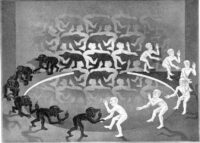I’ve been spending time lately watching live and recorded transmissions from the International Space Station. Unlike the videos and transmissions of the past with poor image fidelity and sound, the quality of the current transmissions is fantastic. The color is great, the image clarity and focus are perfect, and the sound is clear and clean.
Traveling at 216 miles above the earth, 1,140,480 feet, the space station has had as many as 13 occupants – including the crew of the space shuttle. 216 miles seems so close, particularly when you consider distance on the ground. San Francisco and Los Angeles, for example, are more like 600 miles from each other. Yet at 216 miles from the surface of the earth, gravity creates orbital equilibrium against the centrifugal force of the station, speeding around the globe at over 17,000 miles per hour. Within the station, it’s all free-floating, not the least of which is human hair – prone to stand straight up it seems in the absence of gravity.
The conversations between station inhabitants and personnel on the ground are unfailingly polite, filled with “great job, thank you, exceptional work, professionally done” and other such superlatives. I suppose it’s a way to help insure the space station crew feels appreciated and uplifted; a depressed space station crew makes for lousy conversation.
Watching the Extra Vehicular Activities, meaning working outside in space suits, are particularly interesting. From time to time, a camera view shows the earth as backdrop, moving quickly below the rotating station. With the speed of 17,227 miles per hour the station circles the globe in 91 minutes, and one gains a sense of this speed as Africa or Asia quickly slide out of view. Moving from hand-hold to hand-hold using grab bars installed on the outside surface of the station, the astronauts twirl and glide themselves in any direction, like acrobats or gymnasts of exceptional talent. There’s no net in space, no safety mats, no spotters. One big mistake and an astronaut can quickly become floating space debris.
NASA has its own cable TV channel, which I guess we’ve all helped finance. Personally, I’m fine with that fact. I like the idea of people living in space, floating the day away weightless, lighter than a feather. I like the idea of looking down on our planet, like a watchful parent minding a beloved child. I like that people of various nationalities live together in the station, and the presence of both men and women. In its way, like a home-made version of Star Trek, the space station presents us with the model human society: polite, virtuous, clean, industrious, non-discriminatory, multi-cultural, non-sexist, and courageous.
It’s too bad I’m the only watching NASA TV; I’ve yet to find anyone else who enjoys seeing people live and work in outer space. On one level, it’s terribly boring. There’s no plot line, the projects include unscrewing and screwing many steel bolts, the space suits look clunky, the inside of the station is cluttered and gray, and there are no special effects. On the other hand, I keep reminding myself that these people are in outer space; floating, no atmosphere, outside temperatures of 250 degrees in the sun, and minus 250 degrees in the shade, unprotected from high energy cosmic rays, vulnerable to death in an instant. The most exciting real time, non-scripted reality show, ever!




